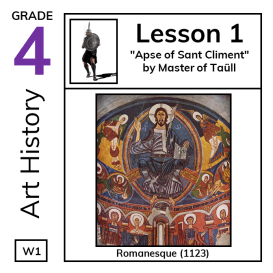
By: Master of Taüll
Week: 1
The Master of Taüll painted the European Romanesque fresco 'Apse of Sant Climent de Taüll,' around 1123. Originally painted on the interior of Sant Climent de Taüll, a Spanish church, it was later transferred to canvas and relocated to a museum in Barcelona. The work combines scenes from the Christian Bible to depict Judgement Day. The haloed and robed Jesus Christ of the Christian religion sits in heaven and rests his feet on the Earth. He raises the two fingers of his right hand to bestow a blessing while holding a book in his left hand. The book reads, 'EGO SUM LUX MUNDI,' which means, 'I am the light of the world.' Etched in white over his shoulders are the symbols alpha, meaning God is the beginning, and omega, meaning God is the end. The four winged and haloed angels surrounding Christ represent the Four Evangelists credited with writing the four Gospels of the New Testament of the Bible. The angel on the top left holding a book represents St. Matthew. The angel on the top right cradling an eagle represents St. John. The angel on the bottom right holding the tail of a winged bull represents St. Luke. The angel on the bottom left grasping the hind leg of a winged lion represents St. Mark. Below Christ, the lone female figure symbolizes the Mother of God. She holds aloft a bowl symbolizing the blood of Christ. The other men represent additional saints and apostles.
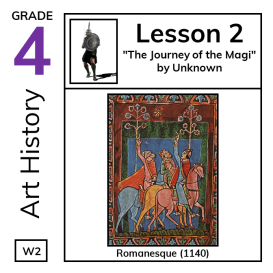
By: Unknown
Week: 2
Around 1130-1140, an unknown artist created 'The Three Magi from the St. Albans Psalter' for an illuminated manuscript of the Book of Psalms. The artist portrays the Biblical Three Magi (the three wise men) riding on horseback and pointing up to the eight-pointed Star of Bethlehem. The appearance of the Star signaled the birth of Jesus and inspired the Three Magi to travel to Bethlehem to worship the newborn king.
By: Unknown
Week: 3
Around 1140, an unknown artist created 'The Harrowing of Hell' for the Psalter of the Queen of Jerusalem, Melisende. The 'Harrowing of Hell' refers to the Biblical telling of the descent of Jesus to hell (i.e. Hades) to battle evil and free hell's captives [2]. This artwork shows Jesus freeing Adam and Eve from hell as King David and other Biblical figures observe nearby.
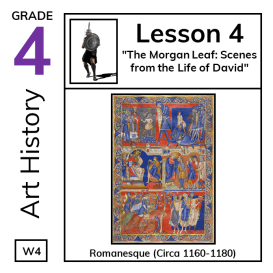
By: Unknown
Week: 4
Circa 1160-1180, an unknown artist created 'Scenes from the Life of David' for the Morgan Leaf of the Romanesque Winchester Bible. This illustration depicts six scenes from King David's life. 1) In the upper left, the young shepherd David swings a stone in a sling while battling the giant Philistine Goliath. David ultimately triumphs over Goliath, striking Goliath's head with a stone. 2) In the upper right, David beheads Goliath with a sword. 3) In the middle left, jealous of David's victory, King Saul points a javelin at David. 4) In the middle right, David is crowned King of Israel. 5) In the bottom left, King David's son, Absalom, is killed. 6) In the bottom right, King David covers his face and mourns the death of Absalom.
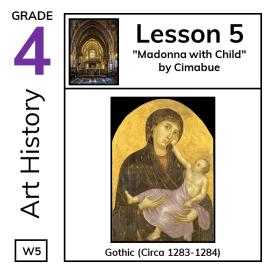
By: Cimabue
Week: 5
The next four lessons introduce the Gothic era which lasted approximately from the 1100s to the 1500s. Trends in art include better rendering of lifelike figures, artwork expressing emotion, and expanding to address secular topics. Between 1283 and 1284, Cimabue painted 'Madonna with Child.' Cimabue deviated from the traditional flat, two-dimensional Romanesque style [2]. Accordingly, 'Madonna with Child' has three-dimensional aspects, especially the facial features and body contours of the subjects along with the draping of the clothing. This painting features the Biblical Virgin Mary and the baby Jesus. Mary serenely watches the viewer while Jesus looks at Mary and tenderly touches her face. Mary wears a patterned robe and Jesus is draped in a shimmering, slightly translucent cloth. Faint halos encircle the heads of both mother and child.
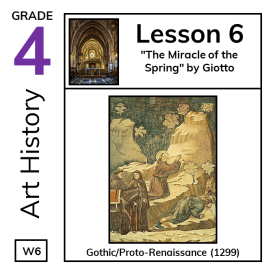
By: Giotto
Week: 6
In 1299, Giotto di Bondone created the Gothic/Proto-Renaissance fresco, 'The Miracle of the Spring.' This work is the fourteenth of twenty-eight frescoes capturing the Legend of Saint Francis of Assisi. The frescoes are located in lower part of the nave of the Basilica of Saint Francis of Assisi in Assisi, Italy. Giotto advanced beyond typical Gothic-style painting of the times, moving toward Renaissance-style artwork. Giotto may have been a pupil of Cimabue (this is disputed), and his work eclipsed that of Cimabue. 'The Miracle of the Spring' depicts the story of the journey of St. Francis to the Monte la Verna monastery. During the trip, a peasant becomes parched and pleads for water. St. Francis prays to God for help, and a spring of water bubbles up from the rocks. 'The Miracle of the Spring' shows a haloed St. Francis praying to God, the peasant drinking water from the spring, and two Franciscans standing next to a donkey.
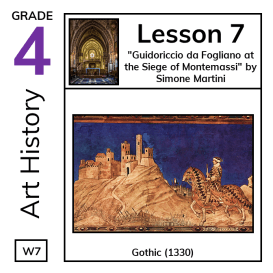
By: Simone Martini
Week: 7
The circa 1330 fresco 'Guidoriccio da Fogliano at the Siege of Montemassi,' provides an example of secular art during the Gothic period. Although traditionally attributed to Simone Martini, the identity of the artist is currently in dispute. This fresco depicts the Sienese commander, Guidoriccio da Fogliano, riding and holding a baton before the siege of Montemassi, Italy. The far left shows the castle of Montemassi encircled by ramparts, in the center is a siege engine topped with a white and black flag, and to the right are groups of tents also flying white and black flags. At the bottom, the number MCCC.XX.VIII stands for 1328, the date of Fogliano's conquest of Montemassi.
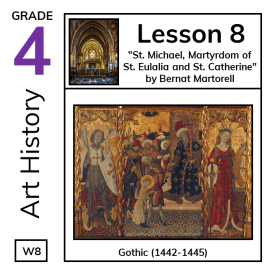
By: Bernat Martorell the Elder
Week: 8
Bernat Martorell the Elder painted the three-part Gothic altarpiece 'Saint Michael, Martyrdom of Saint Eulalia, and Saint Catherine' between 1442-1445. The left part shows the winged archangel Saint Michael slaying a beast of hell. The center portion shows Saint Eulalia of Mérida surrounded by the Roman governor Dacian and his soldiers. According to legend, Saint Eulalia became a martyr for her Christian beliefs as a young teenager. When she died, a dove flew from her mouth and a miraculous white snow covered her body, frightening her tormentors. The right portion of the artwork shows Saint Catherine of Alexandria. According to her hagiography, she was a princess who converted hundreds of people to Christianity before being martyred by Maxentius, a pagan Roman Emperor. Note: According to [3], some modern scholars believe the story of Saint Catherine was based on the pagan philosopher and mathematician Hypatia who was murdered by an angry mob for her pagan beliefs.
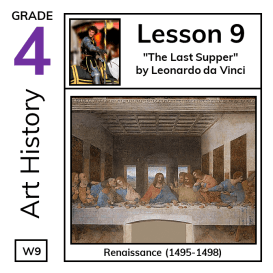
By: Leonardo da Vinci
Week: 9
In the next four lessons, we move to the 14th-17th centuries and the Renaissance era, a time of philosophical, literary, musical, artistic, and scientific revival across Europe. Renaissance art expanded to incorporate stories from mythology and history. New techniques led to advances in portraying proportion, depth, and three-dimensionality. 'The Last Supper,' painted between 1495-1498 by the ultimate Renaissance artist, Leonardo da Vinci, shows Jesus sharing one last dinner with his Apostles before his death. The painting captures the moment Jesus reveals one Apostle will betray him. From left to right (head-wise), the painting subjects are as follows: Saint Bartholomew, James (son of Alphaeus), Saint Andrew, Judas Iscariot, Saint Simon Peter, John the Apostle, Jesus of Nazareth, Saint Thomas the Doubter, James the Greater, Saint Philip, Saint Matthew, Saint Jude Thaddeus, and Saint Simon the Zealot. The dark haired and bearded betrayer, Judas Iscariot, holds a small bag (perhaps representing his payoff for betraying Jesus) and spills a salt cellar. To the superstitious, spilling salt causes bad luck or presents an evil omen of things to come.
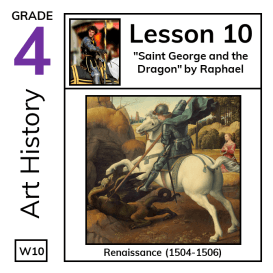
By: Raphael
Week: 10
We continue the study of Renaissance art with 'Saint George and the Dragon,' painted by Raphael between 1504-1506. Saint George and his charging steed battle a ferocious winged dragon to rescue a haloed lady in pink. Saint George wears a suit of armor and a helmet topped by a golden halo. He pierces the snarling dragon with his lance. Trees and tall buildings rise up from the horizon in the distance.
By: Titian
Week: 11
The artist Titian painted the next Renaissance artwork, "Bacchus and Ariadne," between 1520-1523. Set on the Greek island of Naxos, the god Bacchus leaps from a chariot to rescue the Cretan princess Ariadne from two cheetahs. Trailing behind Bacchus is a group of his revelers. Sparkling above Ariadne is the constellation, "Northern Crown" (Corona Borealis). In the foreground, a King Charles Spaniel barks at a young satyr.
By: Pieter Bruegel the Elder
Week: 12
The final example of Renaissance art is Flemish artist Pieter Bruegel the Elder's 1560 painting 'Children's Games.' The painting depicts boys and girls of all ages gathered in a central area of town and enjoying all sorts of fun, including gymnastics, wearing masks, swimming, rolling hoops, riding hobby horses, making art, spinning, playing leapfrog, enjoying toys, and riding on barrels.
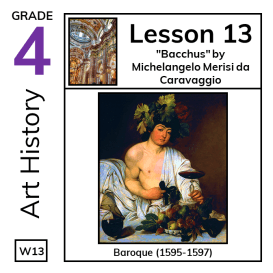
By: Michelangelo Merisi da Caravaggio
Week: 13
The next four lessons advance to the Baroque era of the 17th and 18th centuries. Baroque artists and architects overwhelmed the senses with highly detailed and ornate works of grandeur. Baroque painters used warm tones and primary colors to infuse their works with movement, emotion, and vibrancy. In contrast to the balance and symmetry of the Renaissance, Baroque artists used asymmetry to show action. Religious and mythological themes still dominated Baroque artwork. The Baroque period included increasing realism and variations of still life painting such as vanitas (reflecting on mortality and the passage of time). Characteristic techniques included overlapping objects in paintings, illusion, flowing lines, and using light and shade for impact. The first example of Baroque art is Caravaggio's 1595-1597 portrait of Bacchus, the Greek god of wine and revelry. Crowned by leaves and grapes, a young Bacchus offers a goblet of wine to the viewer and fiddles with his robe tie. A glass carafe of red wine and a bowl of apples, pears, grapes, pomegranates, and other fruit glimmer before him. Intriguingly, this painting hides secrets imperceivable to the human eye. In 2009, infrared technology revealed that Caravaggio painted a tiny image of himself holding a paintbrush and working at an easel on the carafe of wine.
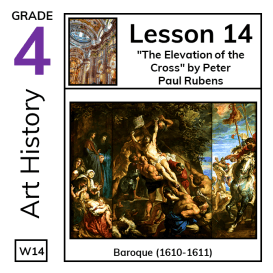
By: Peter Paul Rubens
Week: 14
'The Elevation of the Cross,' a triptych painted by Peter Paul Rubens between 1610-1611, provides the next example of Baroque artwork. The left panel features the Biblical Virgin Mary and John the Evangelist standing. A distraught huddle of women cringes below them. The center panel depicts a group of muscular men straining to lift Jesus onto the cross. The right panel shows Roman soldiers dragging two thieves who are soon to be crucified along with Jesus. An imminent solar eclipse adds to the sense of foreboding.
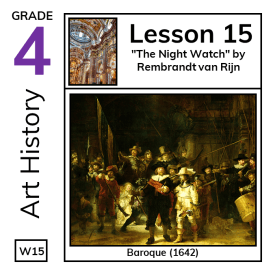
By: Rembrandt van Rijn
Week: 15
Rembrandt completed his Baroque masterpiece, 'The Night Watch' in 1642. In the foreground, Captain Frans Banning Cocq, dressed in black with a red sash, gestures to his white-clad lieutenant. Figures in motion overflow from the background, including city guardsmen holding arquebuses and pikes, one guardsman raising a banner, a drummer, a snarling dog, and a female mascot wearing a dead chicken on her golden dress (the claws symbolize the guild of the guardsmen). This painting exemplifies Baroque characteristics such as the dramatic use of light and shadow, movement, and overlapping figures. Interestingly, in the 1800s, the painting was misnamed as a night scene [3]. Look closely to see how bright sunlight casts the shadow of Captain Cocq's hand. Until being restored in the 20th century, years of accumulated grime gave the painting the appearance of night. Over the years, the painting has been the target of multiple attacks [4]. In 1911, frustrated by his joblessness, a former shoemaker and Navy chef stabbed the painting. In 1975, a mentally ill and jobless schoolteacher slashed the painting. In 1990, an escaped psychiatric patient sprayed the painting with acid. Despite the attacks, the painting perseveres and is due for additional restoration starting in 2019.
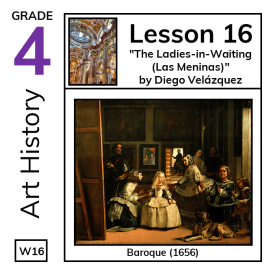
By: Diego Velázquez
Week: 16
The last example of Baroque art is 'The Ladies-in-Waiting (Las Meninas),' painted by Diego Velázquez in 1656. What at first appears to be a simple painting of a young girl and her attendants transforms into a complex piece upon closer examination. Set in Velázquez's art studio in the Madrid palace of Spanish King Philip IV, the central figure is King Philip's five-year-old blonde daughter in white, the Infanta Margarita. Two richly dressed ladies-in-waiting attend to the princess, one kneeling and offering the princess a drink and the other curtsying. Two dwarfs stand to the far right, the young boy prodding a dog with his shoe. In the back right stand the princess's chaperone speaking with a bodyguard. Outside the room, the queen's chamberlain pauses on a set of stairs and peers into the room. Velázquez has also painted himself, paintbrush and palette in hand. A mirror set on the wall shows a reflection of the King and Queen standing behind the viewer, perhaps the subjects being painted by Velázquez. Study each character and try to figure out who or what each character is observing. For example, do you think the princess is watching you, the viewer, or her parents as they are being painted?
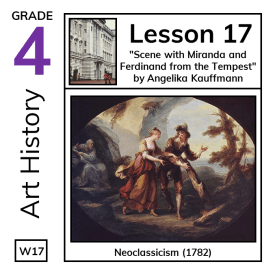
By: Angelika Kauffmann
Week: 17
The next four lessons move forward in time to 1760-1830 and the Neoclassical era of art. In part inspired by Roman and Greek ruins, Neoclassical artists harkened back to the classical art and architecture of Ancient Rome and Greece. In contrast to the Baroque era's emphasis on extravagance and asymmetry, Neoclassical art and architecture returned to simplicity, harmony, proportion, and balance. Art pondered deeper meanings, rather than overwhelming the senses with color and detail. Common themes include works of fiction, Greek and Roman mythology, and history paintings. The first example of Neoclassical art is Swiss painter Angelika Kauffmann's 1782 depiction of the island shipwrecked lovers Miranda and Ferdinand from William Shakespeare's 'The Tempest.' In the background, Miranda's father, Prospero, watches over the young couple. In the scene, Miranda offers to help Ferdinand carry some wood for Prospero, but he refuses, believing it beneath her. Later in the conversation, Miranda and Ferdinand reveal their mutual love and decide to marry.
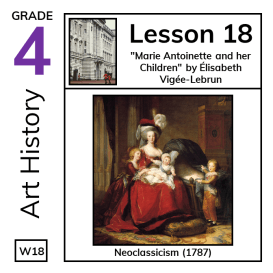
By: Élisabeth Vigée-Lebrun
Week: 18
The next example of Neoclassical art is Élisabeth Vigée-Lebrun's 1787 history painting, 'Marie Antoinette and her Children.' In 1770, when she was only 14, Marie Antoinette, daughter of a Holy Roman Emperor and an Empress of Austria, married King Louis XVI of France and became his queen consort. The people of France believed the Queen was frivolous and wasteful with money. When the economy soured, the French people blamed the King and Queen. Both the King and Queen were found guilty of treason and executed. The painting shows Marie Antoinette clad in a red velvet gown and accompanied by her three eldest children. Her daughter, Marie Thérèse, looks up at her, holds her arm, and leans against her shoulder. Her youngest son, Louis XVII, sits on her lap. Her eldest son, the Dauphin, reveals an empty cradle in remembrance of Madame Sophie, the eleven-month-old baby daughter Marie Antoinette lost. In the background, a curtain is pulled back to show the location - the famed Hall of Mirrors at Versailles.
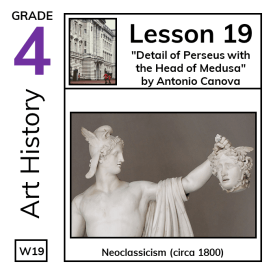
By: Antonio Canova
Week: 19
Neoclassical artist Antonio Canova sculpted 'Perseus with the Head of Medusa' out of marble circa 1800. In Greek mythology, Medusa was a Gorgon monster with snakes for hair, sharp fangs, and wings. Those who looked upon her face turned to stone. Medusa had two immortal Gorgon sisters, but unfortunately for Medusa, she was mortal. Perseus was a mythological Greek demigod who slayed many monsters, including Medusa. After beheading Medusa, Perseus cleverly kept her head to turn his enemies into stone. In the sculpture, in addition to wielding Medusa's head, Perseus wears Pluto's Cap of Invisibility, which rendered him invisible.
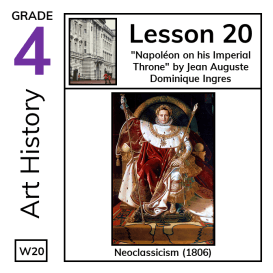
By: Jean Auguste Dominique Ingres
Week: 20
The final example of Neoclassical art is Jean Auguste Dominique Ingres' 1806 history painting, 'Napoléon on his Imperial Throne.' The French emperor, Napoléon Bonaparte, sits on his throne, wearing his coronation outfit which includes a laurel wreath of gold. Eagles and white ivory spheres adorn the throne. A golden eagle and the symbols ANNO (Italian for 'Year') 1806 decorate the rug under the throne. Napoléon holds the hand of justice in his left hand and Charlemagne's scepter in his right hand. Also tucked under his left arm is his coronation sword. He wears the emblem of the Legion of Honor around his neck.
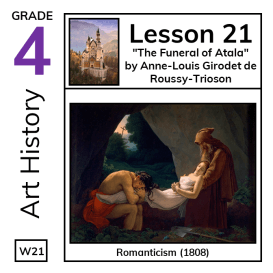
By: Anne-Louis Girodet de Roussy-Trioson
Week: 21
The next four lessons embrace the Romantic era of art, occurring circa 1770-1920. Romantic artists strove to capture emotion in their works, such as horror, true love, serenity, sorrow, despair, and wanderlust. Romantic artists also emphasized imagination, mysticism, and nature, partly in response to scientific rationalism and the Industrial Revolution. Rather than drawing from classical antiquity like Neoclassical artists, Romantic artists gained inspiration from medieval times. A move toward nationalism was also evident in art. The first featured romantic work, 'The Funeral of Atala,' was painted by Anne-Louis Girodet de Roussy-Trioson in 1808. The painting draws from François-René Chateaubriand's 1801 novella 'Atala,' which was set in America in the 1700s. The picture shows American Indian Chactas mourning the death of his beloved Atala in a cave at sunset. Atala took her own life in order to remain true to her Christian values, symbolized by the two crosses in the painting. A cloaked missionary named Father Aubry cradles Atala's upper body. A shovel lies nearby, reminding the viewer of the burial to come.
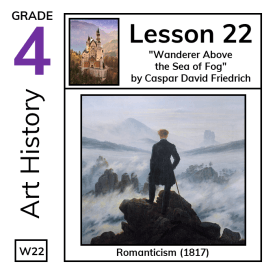
By: Caspar David Friedrich
Week: 22
Caspar David Friedrich's 1817 work, 'Wanderer Above the Sea of Fog,' provides a second example of Romanticism. A well-dressed and wind-blown man holding a walking stick looks out over a foggy, craggy landscape. Trees sprout here and there from the other rocky peaks. The man has already conquered one mountain peak and perhaps longs to venture further into the unknown landscape of life.
By: Gustave Courbet
Week: 23
Gustave Courbet painted his Romantic self-portrait, 'The Desperate Man,' between 1843-1845. The artist shows himself wide-eyed and frantic. His hands tear at his flowing brown hair. What has caused his desperation? Perhaps he's unsatisfied with a painting he's working on, his artwork isn't getting the desired recognition, or he's troubled by his finances. Whatever inspired this work, he's captured himself in the throes of despair.
By: John William Waterhouse
Week: 24
The final example of Romantic art is John William Waterhouse's 1908 painting 'The Soul of the Rose.' A lovely woman inhales the fragrance and caresses the velvety softness to experience the very soul of a pink rose. Her auburn hair is beautifully upswept, her cheeks are flushed, her hand rests against the wall for balance, her eyes are closed, and her expression is divine.
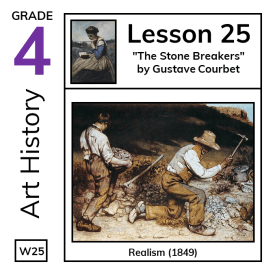
By: Gustave Courbet
Week: 25
The Realist movement (also called naturalism) was prevalent circa 1830-1900. Rejecting the overly wrought works of Romanticism, Realism sought to capture the world accurately and honestly. No longer were only the beautiful, the rich, the powerful, and the mythic worthy of being widely represented in art. Realism portrayed people from all walks of life. The first example of Realism, 'The Stone Breakers,' was painted by Gustave Courbet in 1849. In this painting, two laborers wearing tattered clothing, an old man and a young boy, break up rocks with hammers and gather the resultant smaller rocks in baskets. In the background, a pot, a satchel, and a spoon rest on a white blanket, perhaps to remind us that the laborers most likely struggle to feed themselves and their families.
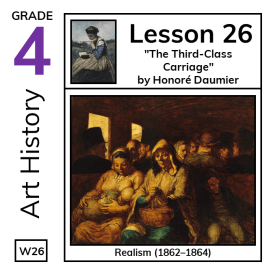
By: Honoré Daumier
Week: 26
Painted between 1862-1864, Honoré Daumier's 'The Third-Class Carriage' captures the exhausted stillness of third-class railway passengers. A mother slumps in her seat as she cradles her child. The elderly cloaked woman clasping a basket serves as a soft pillow for the worn-out little boy leaning against her. The additional passengers in the background are faded and wear muted colors. No one has the energy to smile, chat, or laugh. Even the weather outside appears gray and dreary. The passengers sit on hard benches, not the upholstered cushioned seats most likely enjoyed by the first-class riders. This work was not finished - note the grid of parallel lines overlaying the work, showing it was squared for transfer to another canvas.
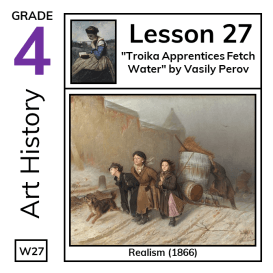
By: Vasily Perov
Week: 27
The third example of Realism, Vasily Perov's 1866 painting 'Troika Apprentices Fetch Water,' tackles the bleak reality of child labor. The painting shows three grim child apprentices wearing tattered clothing and battling the icy wind and gravity to heave a barrel uphill. One male adult, possibly their master, strains to help them by pushing. Another man wrapped in cloth, trudges with the wind in the other direction. A shaggy dog bares his teeth in a snarl against the harsh elements and bounds alongside the children. A few withered leaves cling to the branches of a bare plant bent by the whipping wind. A stick protrudes from the barrel, perhaps used to break up ice. Birds soar overhead through the gray, dismal sky, which partially obscures the city buildings in the background. The viewer can only hope a crackling fire and hot meals await the painting subjects at the end of the day.
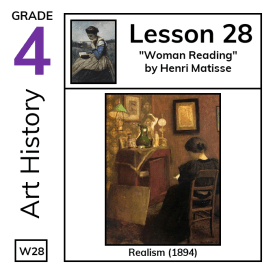
By: Henri Matisse
Week: 28
Henri Matisse's 1894 painting "Woman Reading" provides the final example of Realism. A woman in a black gown faces away from the viewer, relaxes in a wooden chair, and reads a book. Her long brown hair is pulled up, secured by a black bow above the nape her neck. The room is in mild disarray, the wooden cabinet slightly opened and covered in a panoply of items. The cloth covering the dresser is askew, and a canvas rests on the floor. Paintings and a gas lamp add to the chaos of the room. The woman takes no mind of her cluttered reality, immersed in her own private world within the book. This work captures a calm, everyday moment common to many lives.
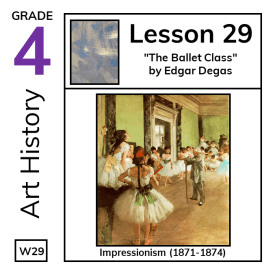
By: Edgar Degas
Week: 29
Impressionism rose to prominence for a short time, circa 1870s-1890s. Like realism, impressionism focused on common subjects engaging in everyday life. Unlike realists, impressionists used thin, visible brush strokes to convey movement and formulate gauzy impressions of their subjects. Impressionists also often painted outdoors, seeking to capture the play of sunlight. Although critics and the public rejected impressionistic works at first, affection for the style grew and the popularity of these works has persisted into modern times. The first Impressionist work, 'The Ballet Class,' was painted by Edgar Degas between 1871-1874. This painting shows a group of ballerinas being instructed by Jules Perrot, who holds a stick to beat time. The rehearsal room is located in the Paris Opera. In the far back, ballerinas, some sitting with their mothers, await their turn to dance. The visible brush strokes of color reveal the impressionistic nature of the work.
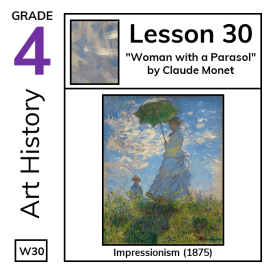
By: Claude Monet
Week: 30
The next example of Impressionism is Claude Monet's 1875 painting 'Woman with a Parasol - Madame Monet and Her Son.' A veiled woman in a white gown stands in a field of flowers and shades herself with a green parasol. A well-dressed little boy stands in the background. Both the woman and the little boy look directly at the viewer. The clouds, flowers, green vegetation, and light are represented using visible strokes of color.
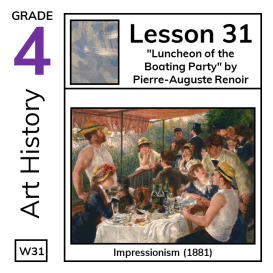
By: Pierre-Auguste Renoir
Week: 31
In Pierre-Auguste Renoir's 1881 Impressionist painting 'Luncheon of the Boating Party,' a group of Renoir's friends gather under a striped awning. They've just enjoyed lunch at Maison Fournaise restaurant along the Seine river in Chatou, France. The nearest table is covered with bottles of wine, a small keg, grapes and other fruit, used glasses, and used cloth napkins. Around the table, one woman puckers her mouth as she coddles a small dog, a man sits on a backward chair, and a man leans over to converse with a seated woman. To the left, a man and a woman lean on a railing. Further back, two men talk to a woman in black who covers her ears with her gloved hands. A woman is caught mid-drink, and a man in a top hat talks with another man. Far beyond the luncheon party, shrubbery grows and sailboats coast along the river. From the title, the group may have already gone boating or about to join the boats out on the water.
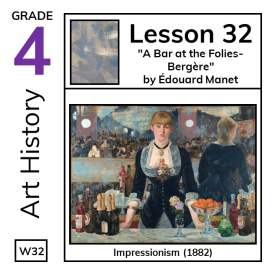
By: Édouard Manet
Week: 32
The final example of Impressionism is Édouard Manet's 1882 painting 'A Bar at the Folies-Bergère.' The Folies Bergère is a cabaret music hall in Paris, France. The painting shows a barmaid looking at the viewer and standing before a mirror. The barmaid is a real woman named Suzon who worked at the Folies Bergère in the 1880s. She wears a necklace, a bracelet, earrings, and a flower. Her expression is a little sad. A variety of bottles, a glass holding flowers, and a dish of oranges rest on the bar in front of the barmaid. By looking at the mirror, the viewer can see what the barmaid sees as well as the back of the barmaid. Look to the upper left to spot the feet of a performing trapeze artist.
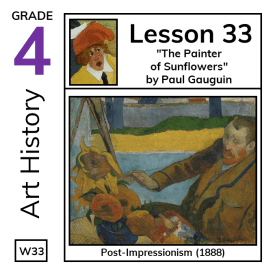
By: Paul Gauguin
Week: 33
The final four lessons of this course address Post-Impressionism, which originated in France in the 1880s and spanned the time between Impressionism and Fauvism. The Post-Impressionists continued to use visible brushstrokes, thick layers of paint, and real-life subject matter. However, unlike the Impressionists, Post-Impressionists used unusual colors, incorporated well-defined geometric forms, and often painted in studios rather than outdoors. Paul Gauguin's 1888 Post-Impressionist painting, 'The Painter of Sunflowers,' shows fellow artist Vincent van Gogh holding a palette and creating one of his famous sunflower paintings. At the urging of Van Gogh, Gauguin traveled to Arles, France to start an art colony. During his time in Arles, Gauguin created this painting. Unfortunately, also during this time, Van Gogh's ear was sliced off. Van Gogh is reputed to have cut off his own ear, although some historians believe he lied to protect Gauguin. Gauguin may have sliced off Van Gogh's ear with a sword during an argument. Unsurprisingly, the planned art colony never came to fruition and Gauguin left Arles after only two months.
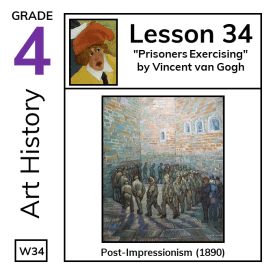
By: Vincent van Gogh
Week: 34
Vincent van Gogh created the Post-Impressionist 'Prisoners Exercising' in 1890. Van Gogh painted these trapped prisoners while caged himself in the Saint-Paul Asylum in Saint-Rémy-de-Provence, France. Van Gogh based this painting off Gustave Dore's print of Newgate Prison in London, England. The painting shows unhappy prisoners marching in a circle for exercise, watched by prison guards and surrounded by high walls. Two white birds flutter overhead, perhaps symbolizing the hope for future freedom.
By: Henri Rousseau
Week: 35
Rousseau created the 1892 Post-Impressionist patriotic painting, 'A Centennial of Independence,' to memorialize the 1792 formation of the first French Republic. Banners wave in the breeze as lively peasants dance the farandole around ladies waving flags and liberty trees. At the far right, politicians in powdered wigs watch the dancers. At the far left, a lady holding a basket and small children watch a drummer.
By: Pablo Picasso
Week: 36
The final example of Post-Impressionism is Pablo Picasso's 1901 painting 'Le Gourmet.' A small girl with a cloth draped over her dress to protect against spills stirs something in a bowl. The color blue is prevalent, as this was painted during Picasso's 'Blue Period.'